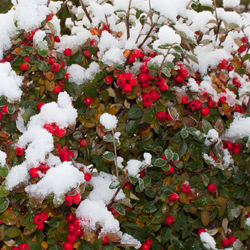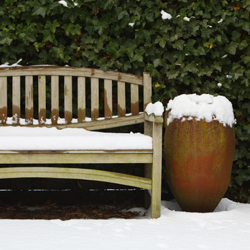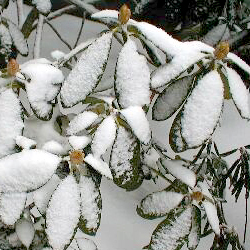![]()
Plant Nursey in Clifton Park, NY
Offering Landscape Design & Installation & Much More!
Seven Top Trees for
Multi-Season Interest
I think that I shall never see
A Poem lovely as a tree…
Joyce Kilmer
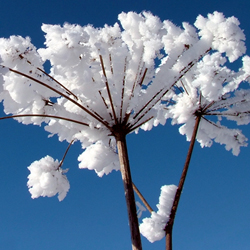
Obviously, we love trees. What’s not to love about a tree? As they grow, their photosynthesis removes and stores CO2, thus maintaining a safe oxygen level for us. Additionally, they provide beauty in our gardens and parks. Many provide shade, fruit, syrup, nesting places, animal refuge, even the subject for poems!
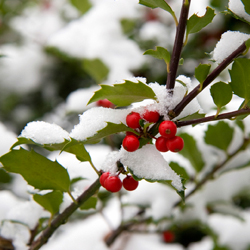
We want you to get the most enjoyment of your trees. Therefore, we have selected seven underused, but special, trees for you. Very hardy, these trees provide all-year interest in mid-Atlantic gardens.
Serviceberry or Shadblow
Amelanchier varieties grandiflora
SPRING: Showy drooping clusters of white flowers as purple leaves emerge.
SUMMER: Leaves turn deep green.
FALL: Vivid fall colors.
WINTER: Open shape is attractive when backlit by winter sun.
GROWTH: Full sun to part shade. Tolerant of many soils.
NOTES: Small trees or tall shrubs to 20-25’ and wide. Many different colors and varieties available.
Katsura
Cercidiphyllum japonicum
SPRING: Heart-shaped 2-4” red-purple leaves emerge and turn bright green. Small flowers in April cast an underlying pink tone.
SUMMER: Numerous small, flat-winged seedpods hang in clusters of 3-5.
FALL: Brilliant fall colors of bright yellow, pink and reds. Leaves produce a sweet candy-like fragrance.
WINTER: Rough, or shaggy, furrowed bark stands out against snow.
GROWTH: Full sun, rich, moist and well-drained soil. Tolerant of alkaline soil.
NOTES: Younger pyramidal shape changes to rounded crown as matures. Very slow growth to 30-60’ tall by 15-40’ wide. Weeping form also available growing to 20’ tall and 10’ wide.
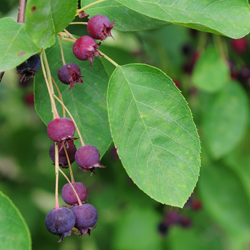
Pagoda Dogwood
Cornus alternifolia
SPRING: 3-4” flat clusters of fragrant white flowers in early spring. Young stems have unique bluish color.
SUMMER: Green fruits turning to red then colorful small blue-black berries. Eaten by over 98 types of birds.
FALL: Leaves turn to brilliant deep burgundy. Bright red fruit stems persist.
WINTER: Leafless unique horizontal branching structure provides visual interest. Ridged bark on older trees is dramatic.
GROWTH: 15’ -25’ tall. Best in cool shaded area in moist, acidic, well-drained soil. Tolerant of full sun and alkaline soil.
NOTES: Native to upper Midwest. Grow as 25’ tall single or multi-trunked specimen providing elegant shape in small landscapes.
‘Winter King’ Hawthorne
Crataegus viridis ‘Winter King’
SPRING: Abundant white flowers in early to mid-May.
SUMMER: Leathery dark green foliage. 3/8” green fruits appear.
FALL: Green turns to golden yellow. Fruits ripen from orange to bright orange-red by late fall.
WINTER: Fruits persist until eaten by the birds. Scaly silvery-gray bark glints in low winter light. Mature tree bark peels off to show light orange inner bark.
GROWTH: Grows to 12’ tall with a rounded crown. Full sun to part shade. Prefers moist, but not water-ogged soil.
NOTES: ‘Winter King’ has few thorns.
Useful in small landscapes, parking lots, and as street tree.
Seven-Son Flower
Heptacodium miconioides
SPRING: Glossy attractive leaves unfurl in May.
SUMMER: Fragrant, jasmine-like white flowers emerge in late summer at branch tips.
FALL: Flowers mature to form red-purple fruits with pink calyxes, changing to persisting bright red.
WINTER: Easily seen after leaves drop, light brown or bronze peeling bark reveals deeper brown underneath.
GROWTH: Full sun to part shade.
NOTES: Grows 15-20’ tall and 10-15’ wide either as single or multi-trunked small tree.
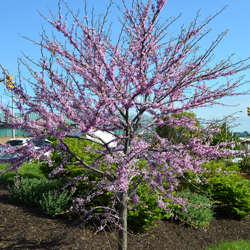
Flowering Crabapple
Malus varieties
SPRING: Green or purple red leaves before or after profuse white, pink, red or purple single or double flowers.
SUMMER: Flowers turn to brightly colored fruits enjoyed by birds.
FALL: Beautiful fiery fall foliage colors.
WINTER: Bark of young trees is greenish brown. Changes to shiny brown-gray.
GROWTH: 20-25’ tall and wide. Weeping form available. Full sun, well-drained soil.
NOTES: ‘Prairifire’ has bright red flowers followed by 3/8” red-purple fruits. Bark is red-brown, accents the vivid fall foliage.
Stewartia
Stewartia pseudocamellia
SPRING: Purple-tinted young leaves turn dark green by early summer.
SUMMER: Camellia-like white flowers 2-3” wide with orange anthers in July. Followed by pointed seedpods.
FALL: Orange and red colors blaze in fall.
WINTER: Outstanding bark flakes off as layers to show gray, reds and orange under-colors in all seasons. Especially showy against snow.
GROWTH: Full sun to part shade. Best in rich, well-drained acidic soil. Protect from hot afternoon sun.
NOTES: Slowly grows to 20-40’ tall as multi-trunked rounded columnar tree.
Of course, these aren’t the only trees with year-round interest. Harry Lauder’s Walkingstick, paperbark maple, tri-colored beech, ‘JN Strain’ musclewood, and the various cherries, are among so many others.
Come on in to see our diverse and incredible selection of beautiful trees. We’ll help you select the perfect one for your landscaping needs and ensure you enjoy it throughout the year. The birds, animals and earth will thank you and maybe, you’ll even write your own poem!















